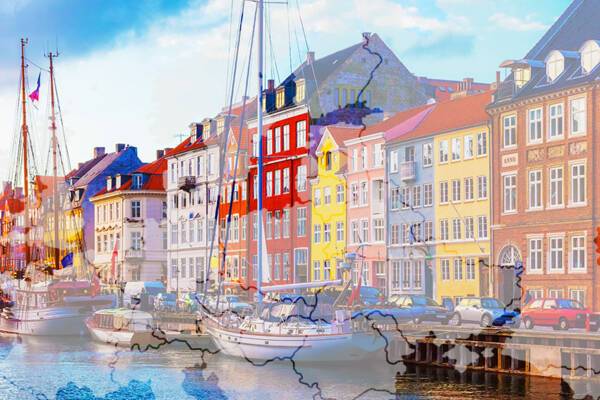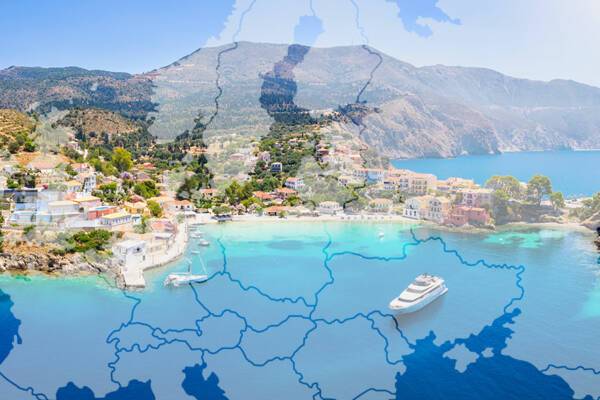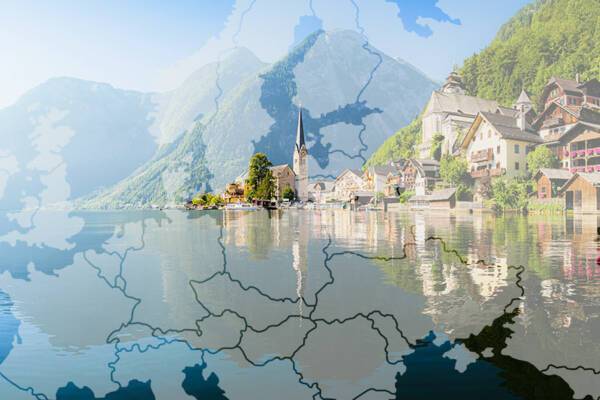Call us FREE 0808 2394 989
Opening Hours - Office closed, we'll open at 8:30am
Call us FREE 0808 2394 989
Opening Hours - Office closed, we'll open at 8:30am

A list of dishes you should try in every European country
Published on 27 Mar 2023
Food is one of the most important parts of any travel experience. And on a cruise, you have the unique opportunity to sample new and exciting local cuisine every day. If you only have one day to spend in a new city, region or country and are struggling to narrow down your long list of bucket list dishes, perhaps we can help. Read on to find out the best European dishes to try on your cruise to Europe:

The Danes enjoy smørrebrød for breakfast. It’s an open sandwich with dark brown rye bread topped with various ingredients such as fish, meat, fresh herbs or eggs. It can be made vegetarian or vegan and you’ll find it in restaurants and cafés throughout Denmark.
Sprats are small fish found in abundance in the Baltic Sea. “These little smoked fish in oil remind Estonians of their childhood, as they used to be really popular even then,” the team from Visit Estonia told us. “They are to be eaten with fresh bread and butter, like an open-faced sandwich. And, of course, bread - Estonians have a love affair with their bread - a dietary staple and cultural identifier.”
We asked the team which other dishes they recommend you try on your cruise to Estonia, “Kohuke! These little batons of cottage cheese are covered in various flavours of chocolate and are some of the most popular snacks in Estonia. They come individually wrapped and are the perfect mix of sweet and creamy. We’d also recommend kama, a traditional Estonian finely-milled flour mixture. The kama powder is a mixture of roasted barley, rye, oat and pea flour. The oat flour may be completely replaced by wheat flour or kibbled black beans may be added to the mixture. It is used for making some desserts and is mostly enjoyed for breakfast mixed with milk, buttermilk or kefir. Kama is frequently sweetened with sugar and especially with blueberry, honey or served unsweetened.”
Finnish salmon soup, or lohikeitto, is a firm favourite among locals. Made with salmon, potatoes, carrots, onions, dill and a generous helping of cream, it is at once fresh and indulgent. Don’t forget to try Finnish rye bread to soak up the soup.
Fermented shark might not sound like the most appealing dish but it’s definitely worth a try! It’s Iceland’s national dish and certainly not for the faint-hearted. The shark is hung out to dry for roughly four to five months and the dish is fragrant. However, it’s an Icelandic delicacy and served in the smallest of cubes, so you only have to try one.
Alongside a pint of Guinness, you should tuck into a traditional Irish stew while in Ireland. Made with meat and root vegetables, the stew varies across Ireland but is traditionally made with lamb. Early recipes for Irish stew appeared in the 19th century and today, you can sample the dish in the pubs of Dublin during your cruise.
Latvia’s beloved dessert is the rye bread trifle, a delicious tangy dish made with cranberries, whipped cream and a black rye bread crumble. This dessert is completely unique to Latvia and can be found in traditional and contemporary restaurants.
These generous potato dumplings are filled with pork and smothered in sour cream and bacon sauce. We’re sold! Originally named didzkukuliai, the dish was rebranded due to its resemblance to zeppelin airships.
Directly translated to ‘bent cake,’ this popular Norwegian dessert looks like an ice cream cone and could be considered a Scandinavian cannoli. It’s safe to say that this delicious Norwegian waffle cookie is a must-try when on your cruise to Norway.
The perfect blend of sweet and savoury, traditional Swedish meatballs with lingonberry jam is the ultimate comfort food. Served in a mouth-watering gravy with a helping of potatoes, we’re sure you’ll be going back for seconds.
The team at Visit Sweden told us, “Long before your local supermarket started selling distant relatives of the Swedish meatball, every grandma in Sweden had her own secret recipe since handed down through her family. Now, almost every Swede can whip together handmade meatballs for the family in two shakes of a moose’s tail.
“Great meatballs represent good old fashioned comfort food, reminiscent of a frying pan sat atop the wood-fired stove in grandma’s country kitchen as they gently roll around in the pan. Of course, no good meatball is complete without a generous helping of lingonberry jam (more akin to marmalade than jam). Paired in much the same way as Brits match turkey and redcurrant jelly. These bright red berries grow profusely across Sweden in the autumn and have been proven to be a superfood, according to researchers at Lund University. Eaten for centuries, Swedes must have known subconsciously how good they are for us as part of a healthy, balanced Nordic diet.”
Varieties of fish and chips can be found worldwide, from shrimp fritters in Spain to Alaska’s halibut and chips. However, the original (and some might argue the finest) come from the UK. The dish first appeared in the 1860s, and by 1910, there were reportedly more than 25,000 fish and chip shops across the UK. This classic meal is best enjoyed by the seaside and for vegetarians, the chips alone are a real treat.

Khorovats is a selection of delicious meats, grilled on a shampooer or skewer. An Armenian barbecue is often made with meat still on the bone and the most popular ingredient is pork. The meat is marinated and grilled for a distinct smoky flavour.
Azerbaijan’s national dish plov is a delicious rice dish infused with saffron. Long grain rice is steamed with saffron and served on top of a golden crust called gazmag, which is made of eggs, flour, butter and yoghurt. Many versions of plov include meat, dried fruit, fresh herbs, fish and other vegetables.
Vegetarians will love Belarus’ recommended dish - draniki. These delicious potato pancakes are fried with a crispy outer layer and a fluffy centre and served with sour cream and vegetables. Belarus is one of the world’s top potato-growing countries, so it’s safe to say they know what they’re doing.
A banitsa is a traditional Bulgarian food made by layering a mixture of eggs and cheese between filo pastry before baking it in the oven. Its distinctive pinwheel shape and simple yet full flavour make it a hugely popular food in Bulgaria, and one well worth seeking out during your holiday.
A pungent variety of soft cow’s cheese originated in the city of Olomouc. The European Union has listed it on the Protected Geographical Indication, meaning that, in order to be considered authentic, it must have been made in this specific region of the Czech Republic.
Hungarian goulash is made with meat and vegetables and seasoned with paprika. Its distinct flavour and hearty nature make it a popular dish all year round and a must-try during your cruise to Hungary.
Beshbarmak, made with boiled horse or mutton meat, is widely considered to be the most popular Kazakh dish. Its name translates to ‘five fingers,’ because of the way the dish is traditionally eaten. The meat is boiled in a broth called sorpa and served in bowls called keze.
As with much of Balkan cuisine, Kosovo’s most popular dishes consist of pies, fresh salads and delicious bread. One unique dish you should absolutely try is flija. It’s made with multiple pancake-like layers, cream and sour cream. It is simple yet utterly delicious.
This moreish fried bread served warm from the pan is the ultimate street food in Moldova. It is essentially a fried pastry-like bread made with a range of savoury or sweet fillings. Some of the most common are made with cabbage or potatoes but you’ll find apples and other seasonal varieties too.
Pierogis are traditional Polish dumplings made with a range of fillings including sauerkraut, ground meat, cheese and fruits. When on a cruise to Poland, these delicious pastries are worth seeking out to takeaway or eat in, served with sour cream and fried onions.
Sarmales are traditional Romanian cabbage rolls, made with sour cabbage stuffed with pork and beef and sometimes bacon. Varieties of these moreish savoury rolls can be found throughout eastern Europe, however, many argue that Romania’s are the most delicious.
If you’re looking for something tasty to eat while strolling around St. Petersburg, try a pirozhki. These fried buns are stuffed with a variety of fillings, both sweet and savoury.
Slovakia’s national dish is the ultimate comfort food. Brydnzove is the exquisite, creamy, locally-produced sheep cheese that is unique to Slovakia. Coupled with potato dumplings and smoked bacon, you cannot miss out on this dish on a cruise to Slovakia.
Kofte is essentially a Turkish meatball with ground beef or lamb loaded with herbs and spices and served either in sandwiches or with salads and plain yoghurt. This is the go-to dish for many travellers in Turkey but remember to save room for dessert - baklava is a must-try!
This dish put Ukraine firmly on the foodie map and has long been popular in the UK. However, when in Ukraine, you simply must try it. Fun fact - despite being named after the country’s capital, the dish actually originated in France.

Albania’s cuisine, like much of the Balkans, is heavily focused on meat. Its national dish (and one of the most delicious) is tavë kosi - a baked dish of lamb, rice, yoghurt and eggs with a tasty seasoned roux.
Andorra is big on pigs, so if you are too, this classic Andorran sausage is well worth a try. Dry-cured and seasoned with salt and pepper, before being served cold on a platter, embutido is a taste sensation worth seeking out during your trip. Alternatively, try steak tartare, which became popular over the years due to the country’s close relationship with France.
Meat lovers, rejoice! Bosnia and Herzegovina’s recommended dish is grilled minced beef meat in the form of a tasty skinless sausage, served with sour cream, ajvar (a red pepper sauce), feta cheese and chopped onions in a traditional flatbread. The dish can be likened to a Turkish kebab.
If you’re a fan of cheese and pastry, look no further than Croatia. Zagorski Strukli is a popular Croatian dish made with thin pastry and a delicious mixture of cottage cheese, sour cream and salt. In 2007, Zagorski Strukli was inducted to the list of Croatia’s intangible cultural heritage by the country’s ministry of culture.
Halloumi is the national cheese of Cyprus and a must-try when you visit. Also popular throughout Middle Eastern countries, halloumi is a semi-hard, brined cheese made from a mix of sheep’s and goat’s milk. It lends itself to being grilled or fried and is the ultimate Cypriot snack. Vegans will be able to indulge in delicious olives.
This indulgent bread boat is the stuff of dreams. A khachapuri (usually filled with gooey cheese and egg) is best enjoyed by tearing off the crust and dipping it in the cheesy centre. Variations of this unusually shaped dish can be found in different regions of Georgia.
Moussaka is the best-known dish in Greece, made with tomato sauce and minced beef layered with aubergine and bêchamel sauce. What’s not to love? For dessert, tuck into a piece of baklava and toast the meal with a shot of ouzo.
When people think of Italy, pizza is almost certainly the first food that comes to mind. A traditional Neapolitan pizza must be made with San Marzano tomatoes, which grow in the plains south of Mount Vesuvius, and Mozzarella di Bufala Campana, a protected designation of origin cheese with milk from water buffalo.
These slowly braised bundles of beef are worth seeking out on your cruise to Malta. Despite its name, the dish contains no olives. Instead, tender slices of beef are wrapped around a mixture of seasoned bacon, bread crumbs and garlic, with a splash of red wine, before being baked in the oven and served with potatoes or bread.
If you find yourself in Monaco, don’t miss out on the country’s national dish, barbagiuan. Translating to ‘Uncle John,’ this delicious pastry is stuffed with Swiss chard and ricotta, however, ingredients vary to include rice, onion and Parmesan.
Black risotto is a coastal speciality in Montenegro. This unusual yet delicious dish gets its iconic black colour from cuttlefish ink. The risotto is cooked with calamari, white wine, bay leaves, garlic and nutmeg and is a must-try for seafood lovers.
Caldo Verde is a traditional Portuguese soup made with chorizo, potatoes, collard greens, olive oil and salt. The dish originated from the Minho province in northern Portugal, however, today, it’s enjoyed across the nation and can be found in traditional restaurants in Lisbon and Porto.
San Marino is a haven for sweet-toothed travellers. This traditional Sammarinese cake is made of layers of thin wafers with chocolate and hazelnut cream, before being smothered in chocolate fondant. You’ll find it in local bakeries throughout San Marino.
These Serbian doughnuts are enjoyed all year round. The dough is airy, not dissimilar to beignets which are found in New Orleans. Choose from jam, marmalade, chocolate, cinnamon, custard or cream.
Also known as Carniolan sausage, this dish originates from the Gorenjska region of Slovenia. It is listed as a protected agricultural product by the European Union and is best enjoyed with sauerkraut or soup turnip and freshly grated horseradish.
Paella is a Valencian rice dish, traditionally made with mixed seafood (paella de mariscos) or as a mixed dish (paella mixta). Paella can include white rice, beans, meat, fish, saffron, rosemary and artichokes. This classic dish can be found throughout Spain in various forms and is well worth a try during your cruise.
Although Vatican City is just 110 acres in size, with around 1,000 people living within its borders, the country has its own dish. Fettuccine alla Papalina, or The Pope’s Fettuccine, is an adapted recipe of spaghetti carbonara created for the pope in the 1930s.

Weiner schnitzel is an iconic Austrian dish. This thin, breaded, pan-fried veal cutlet is one of the best-known dishes in Viennese cuisine and will certainly not disappoint. Weiner schnitzel is traditionally served with kopfsalat (lettuce with a vinaigrette dressing), potato salad or parsley potatoes.
Originating in Belgium, this classic dish is a simple combination of mussels and frites. The mussels, served in a separate dish, are cooked in a garlic and white wine sauce, while the fries are made perfectly crispy on the outside and fluffy on the inside. When visiting Antwerp or Ghent, this is a must-try meal.
Snails are a French classic and are mostly popular due to the delicious garlic and parsley butter that accompanies them. If you’re brave enough, you mustn’t miss out on this delicacy during your cruise to France. For vegetarians, cheese soufflés are equally indulgent and very traditional, dating back to the 18th century.
Germany is synonymous with sausages and beer. Enjoy a traditional bratwurst on your cruise to Germany and wash it down with a delicious tankard of beer. This classic German sausage is typically made with veal, beef or pork and dates back to the 1300s. Choose from a huge selection of sausages, such as Coburger, which is traditionally grilled over pinecones and Thüringer, a spicy sausage served with mustard.
No cruise to Liechtenstein would be complete without tucking into a plate of käsknöpfle. As well as being fun to say, this moreish cheese pasta dish is a pleasure to eat. It is essentially Liechtenstein’s answer to macaroni cheese, made with spätzle (a type of soft egg noodle which is popular in Germany) and added caramelised onions.
Judd mat Gaardebounen, or smoked collar of pork with broad beans, is one of Luxembourg’s most notable dishes. It originated in the village of Gostingen where the residents have earned the nickname of bounepatscherten, due to their exquisite broad beans.
Pizza lovers should not miss out on trying pastrmajilja when visiting Macedonia. This oval-shaped bread pie is loaded with salted and dried meat (usually sheep or lamb) and is utterly delicious. In its honour, the city of Stip organises an annual festival.
Bitterballen is a delicious meat-based snack, deep-fried and stuffed with a creamy mixture and plenty of seasoning.
“Dutch cuisine doesn’t have a great reputation,” Vicky from Amsterdam Foodie told us. “But like Britain in the 90s, it’s improving in leaps and bounds. It used to be a bit bland (lots of potatoes, a bit of meat and a few simple veggies) but there’s now a huge growth in modern Dutch and European restaurants serving local produce in really creative ways.
We asked Vicky why bitterballen is such a popular food in the Netherlands, “Because they go perfectly with beer, the national drink of choice! Dipped in mustard, they’re even better. Just beware of eating them too quickly - they’re always nuclear hot in the centre.”
Any cheese fanatic will know about fondue but for those not in the know, this dish of rich, melted cheese is served in a communal pot and enjoyed by dipping in bread using long-stemmed forks. The earliest known recipe for cheese fondue was published in a book in Zurich in 1699, which called for the cheese to be melted with wine and eaten with bread.